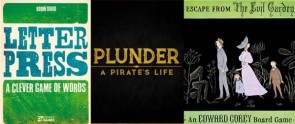A word game, a pirate game, and a terrible game.
Robin David’s Letterpress, a small-box card game from the venerable Osprey Games, offers would-be wordsmiths a quite excellent drafting experience that rewards a little planning, a little risk, and a little smarts. The graphic look is excellent, the price is low, and the rules are slim making it an accessible and appealing choice beyond the confines of hobby gaming, and I wouldn’t be surprised to see this great design grabbing folks looking for something beyond the usual, anodyne selections such as Scrabble or Bananagrams.
The genius isn’t so much in the vocabulary or spelling acumen of the players – you won’t likely ever see million dollar words like “parthenogenesis” or “brobdingnagian”; you are more likely to win with a word like “wobbly” or “belts”. The smartness is in leveraging draft mechanisms to create words from the letter cards players select throughout the game. Each round begins with players looking at five letter cards, each with a points value. It’s a standard pick-and-pass routine as the assortment makes it way around the table. There are also three publically available letter cards that can be used to form a word as well as a “guaranteed” vowel available for use. Any card can be used as a double letter, so you need not worry about getting as second B for “wobbly”.
Once the drafting dust settles, everyone forms a word with their hand cards and any public cards. There are always three challenge cards available that offer bonuses if you meet specific criteria with your word such as having a word worth a specific value or using a certain number of letters. The highest scoring word then gets to draft two cards from everything on display, tucking these cards into a Library. Some challenge bonuses let you add extra cards to your Library, which is definitely a desirable thing.
The fifth round plays out differently. Everyone takes all of their cards acquired from throughout the game and then forms a word from those, with the winner being the player who comes up with the most valuable word. Maybe you banked that X or Z in there hoping to hit paydirt but you never managed to get the other letters you needed for a good word. Or you might blast everyone off the table with a high value word that you drafted your way into over the previous four rounds.
This is such a tight, smartly designed word game. There is no wasted space, there is no sense of the kind of bloat or over-design that characterizes a lot of modern games – it gets back to that notion of a game focusing on a core mechanism and leveraging everything else around the design on it. The result is a game that has exactly the right sense of scope and depth. The draft choices are tough, rewarding both planning and risk-taking not only with each draft choice but also in the longview. The challenge cards are fun to shoot for and can give you an edge, but you might lose a chance to draft a letter or two you might be hoping for.
I’ve enjoyed this game at all player counts and there is a solo variant that puts up quite a formidable challenge. I’ve played with kids, I’ve played it with the elderly. Hardcore gamers and those who haven’t played a card game like this ever in their lives. The results were almost universal- a sense of delight and engagement. It’s the kind of game anyone can enjoy because there is something fundamentally satisfying about forming words from a jumble of random letters – and even more so when it is in the context of a competitive game driving players to decide on which letters they want to take a chance.
Plunder: A Pirate’s Life
I’m going to be dead-level honest with you. If you regard yourself as a “modern gamer” or you fancy that you are fan of sophisticated, clever designs then you are probably going to want to skip Plunder: A Pirate’s Life from from moonlighting Hollywood screenwriter KC Schrimpl and Lost Boy Entertainment. This unorthodox-for-2020 game is an atavistic design that feels like an artifact of a timeline where game development went from Risk onto the Parker Brothers and Milton Bradley games of the 1970s and then ended somewhere around Settlers of Catan. It stands defiant of trends, almost as if endless crowdfunded worker placement games, deckbuilding doppelgangers, and games where the goal is to turn brown cubes into darker brown cubes never existed.
Generally speaking, when we here at ThereWillBe.Games are offered an unsolicited review copy it’s usually not very promising and I almost always pass on the offer. But Plunder interested me because I like light pirate games and this one had these cool, chunky pirate ships that you stick crew, cannons, and masts into like the people pegs in The Game of Life. I thought that was cute. And it also had not one but two spinners, and spinners are awesome. So I decided to give this outsider title a shot, and I’m glad I did because it was oddly refreshing. I’d never consider it to be one of the Great Games of Our Time and I think its appeal is likely to be almost non-existent among “serious” hobbyists, but I’ve had fun with its simple meat-and-potatoes gameplay.
It’s played over a big, modular sea map peppered with islands. Everybody starts with one crewed-up ship in a port. You roll a navigation die to generate movement points (a fancy way of saying “roll and move”). If you land at another island’s port, you can shoot at it to take it over, going for the highest D6 roll against it. You want to take over islands because each one you control gives you an extra draw from the resource card deck, and you spend these to purchase upgrades from a Settlers of Catan-like bill of fare. Masts give you +1 movement, cannons give you +1 on combat die rolls, crew are your ship’s hit points. You can also buy additional ships as well as “Plunder Points”, which are how you win the game. Each ship and each island also counts for a Plunder Point, and the first to seven wins.
There’s plenty of interaction – this is not a stare-at-your-player-board affair. Pull up next to a rival ship, and you can shoot it out with them. Or, you can bring your cannon-laden ship round the horn to bear on a weak enemy and threaten them, demanding resources. You can also trade with other players if you are looking to ditch a surplus of Rum for some Iron to gun up one of your vessels.
It isn’t nearly as narratively detailed as something like Christian Marcussen’s Merchants & Marauders, but there is a storm that moves around the map with the spinners, it’s an odd plastic frame indicating a zone of difficult movement. There are also treasures, which are likely to drive those serious gamers up the wall. These are placed randomly (again, with the spinners) and when a ship moves onto them, the player draws a treasure card. There’s a bit of generic flavor text on these event cards to add just a tiny touch of atmosphere. And they are wildly unbalanced and sometimes punitive.
Some will give the finder a stash of resources. Others may steal resources from others with no opportunity for defense or recourse. There are bad design chestnuts like skipping a turn and losing a Plunder Point. But you know, it’s the kind of game where the imbalance and the sometimes arbitrary take-that is really just kind of par for the course. You either roll with it, or you chicken out and take out some of the more offending cards from the deck. I started to do that but then I fell back on my mantra for gaming – “it ain’t that serious”.
I like this game. I’ve had good fun with it up to four players, it supports six but I think it’s not a great idea to play with that many as it hits the time I’m willing to play this game ceiling with four. I think it’s fun to upgrade these ships, scoot them around, cuss at a string of terrible die rolls, and completely ruin several turns of a player’s efforts with a card play. But there again, I’m likely in the minority among hobbyists and I wouldn’t be at all surprised to see this game get completely bagged on by some of the other content creators and reviewers out there who never grew up in times when goofy, wild games like this were more the norm than the overbalanced, overdesigned, and overwrought machines demanded by players today. Casual players looking for a fun, rowdy pirate game will likely be more pleased with this unusual title.
Escape From the Evil Garden – An Edward Gorey Board Game
Now, remember my admonition about unsolicited review copies up there? Here’s an example of how it can go wrong. We were offered a copy of this game by Pomegranate Communications, a stationary company that has the blessing of the Gorey estate to produce paper goods with his lovely, timeless illustrations and verse. I had to check it out, because I love Gorey and I figured at very least I’d have a great looking game.
And I got the very least. It is a great-looking game, offering oversized cards with illustrations from The Evil Garden. The color palette is lovely, the layouts are splendid, and it’s undoubtedly appealing to the Gorey fan. However, it is appealing in the same way that junky gift shop games are – the kinds of games that someone picks up to give as an obligatory present to someone under the assumption of their interest in the subject matter and as alternative to, say, a calendar. This places the game really more in line conceptually with jigsaw puzzles and themed standard card decks than modern board games, even though I think the three credited designers have at least some awareness of contemporary design.
I appreciate atavism and I love it when games thumb their noses at the established, snooty conventions of modern game design. I’m cool with roll-and-move and random event cards. But there needs to be a game there, so to speak, and the game on offer here is paltry and perfunctory. This is like an old fashioned licensed game, back before licensed games had any credibility. There is no effort to really dig into the themes, concepts, and narratives of Gorey’s work. There is no effort to do anything other than to present licensed content in a board game format.
The basic game is, sadly, not worth the nice production and great subject matter. It’s a very basic roll-and-move with the players attempting to make their way through the Evil Garden, occasionally hitting a “move again” space or an Encounter space. These Encounters generally present a scenario based on an illustration where the player has to roll a die to see the outcome or make an if/then choice. The effects are boring- random movement is pretty common or you might be subject to a Mysterious Disappearance, meaning that you are locked away in a special space until you roll a 4+. This in a 2020 design, really? There are also occasional opportunities to collect a +1/-1 token that you can spend to fudge a roll up or down for a more favorable result, and that is the most significant decisions you will make in this game.
The advanced game, dubbed “Entrap”, puts one player in the role of the Garden itself, embodied with its own mover that scuttles around and attacks the other players with a simple high D6 roll combat. Each character also gets their own special ability card which also has a keyword that some encounter cards interact with. None of these are interesting or compelling. The humans have to escape before the encounter deck runs out, and of course the garden has ways to run the deck down to apply some pressure.
Maybe the designers thought that some very basic hobby game elements would elevate this game, but there’s just nothing to engage with. I suppose a table of Edward Gorey fanatics might be somewhat slightly delighted (in a melancholy way of course) to see familiar art and text from a book they most likely own. But the gameplay, such as it is, is just dreadful.
 Games
Games How to resolve AdBlock issue?
How to resolve AdBlock issue? 




















